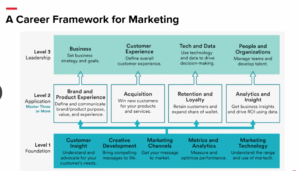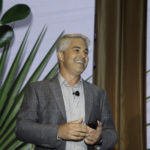“Marketing is hard, but not nearly as hard as building a great team,” Ben Harrel quipped. Arguably the most important touchpoint of a brand’s customer base is mediated through the decisions and actions of its marketing team. Marketing plays an integral role in customer acquisition, retention, and customer experience, but how can you quantify the skills that an ideal marketer needs to succeed? Enter General Assembly (GA); their goal is to transform thinkers into leaders, and their Marketing Standards Board set out to discover what defines a successful member of a marketing team. Kieran Luke, General Manager of Credentials and Business at GA sat down with two members of their Marketing Standards Board at CommerceNext 2019 to discuss and dissect the layers of a framework that make up the skill set of a successful marketing team. Micky Onvural is the CEO and former CMO at Bonobos, and Ben Harrel is the CMO at Priceline. Together, they discussed GA’s standards for marketing specialization and how this framework fits into their own experiences in marketing and customer acquisition.
General Assembly devised their plan to provide a universally recognized benchmark across organizations and build transparent pathways to recognize individuals as members of a marketing team, aiming to prepare the next generation of leaders with the broad skills that they need to contribute to and thrive. Their question arose: what makes a successful marketing team member, and how can brands identify and quantify the skills of a potential marketer. GA’s efforts identified gaps in the way we give marketers training, as well as define the menu of topics that a marketer is expected to know. In the absence of a benchmark for skills, GA compiled a group of thirteen marketing leaders with the aim to agree on a set of skills and benchmarks that would help them effectively train the next generation of leaders in marketing. Among these layers of framework are three tiers: foundations (customer insight, creative development, marketing channels, metrics and analytics and marketing technology), applications (brand and product experience, customer acquisition, retention and loyalty, analytics and insight), and leadership (business, customer experience, tech and data, and people and organizations).
The panelists weighed in on their experience with the levels of marketing framework and how they have integrated these levels into their teams. Onvural and Harrel shared their frustration for the lack of training missing in many marketers’ repertoires from the first tier. By implementing the framework at Bonobos, Onvural aims to help her employees grow and experiment with their positions to find the best fit for them at the company, to find the role where that individual can shine and in turn help the brand grow and develop. She often looks for employees with curiosity and adaptability when building her team and scaling customer acquisition efforts, noting that a business is an oft-changing ecosystem. Harrel chimed in, stating that one of the top things he looks for in a new team member is the “mental horsepower” to not just engage but problem solves, and to be prepared and curious for the problems that are not anticipated. By demonstrating this kind of ownership, members of his team contribute to the development of the brand and the customer experience, rather than just execute from a know marketing playbook.
Both panelists enthusiastically agreed that each employee adds to the company culture and experience, and so they search for new marketers who are curious to become “learners” and grow in and beyond their roles and marketing playbooks. Onvural incorporates the “three E’s” into her employees’ work culture: education, exposure and experience. By encouraging their teams to learn beyond the skills they bring to the table, Onvural and Harrel help them exceed expectations and experiment with new roles to find their best fit in the company while continuing to learn and acquire additional skills from the higher levels of the framework.
By following a frame of reference by which to scale a marketer’s skills, these teams help their members to learn as well as to measure how they learn about different areas and grow into their next role. Harrell noted that his interest in elevating a team member’s role relies strongly on that individual’s interest in exploring ideas and their persistence to try new things and maintain company momentum. These individuals understand the impact of their actions in all facets of the company.
It can be hard to imagine one framework that fits every marketing team regardless of size and goal. “What changes is where you put your emphasis… where you sequence, where you emphasize and where you start,” said Onvural. Laying the base expectations with GA’s foundational layer of skills allows teams to specialize.
Onvural, as the former CMO turned CEO, sees the marketer as the real business owner, connecting with the customer more than anyone else in the organization. “Consumers are increasingly navigating the world by brand, and that puts marketers in a position where they can have a real seat at the table.” These marketers get a more rounded view of the customer and business. Harrell added that the ability to rely on customer data and analytics helps marketers avoid wasted marketing dollars in customer acquisition efforts. GA’s framework is great for scaling a marketing team and its skills helps to structure how you hire, how you promote, and how you lead a team to success.
Related Posts
-
The Power of Storytelling as a Customer Acquisition Strategy
With three years of mattress marketing backed by nearly thirty…
-
Tailoring Your Performance Marketing for Attribution
Attribution is one of the most sought-after yet daunting discussions…
-
Customer Experience and Community as the Ultimate Marketing Tool
If you spend time online, you’ve undoubtedly heard of cult-favorite…





